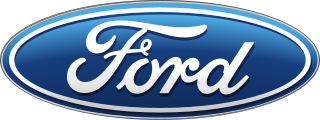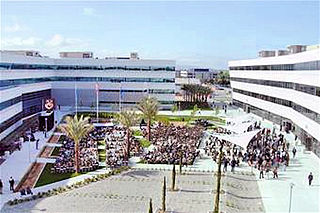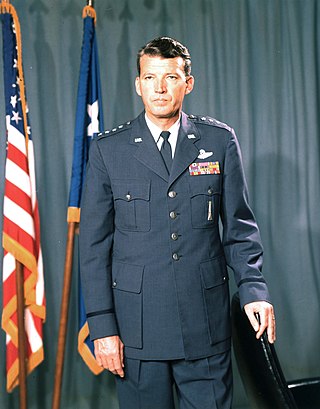Related Research Articles

The Hughes Aircraft Company was a major American aerospace and defense contractor founded on February 14, 1934 by Howard Hughes in Glendale, California, as a division of Hughes Tool Company. The company produced the Hughes H-4 Hercules aircraft, the atmospheric entry probe carried by the Galileo spacecraft, and the AIM-4 Falcon guided missile.

SSL, formerly Space Systems/Loral, LLC (SS/L), of Palo Alto, California, is a wholly owned manufacturing subsidiary of Maxar Technologies.
Loral Corporation was a defense contractor founded in 1948 in New York by William Lorenz and Leon Alpert as Loral Electronics Corporation. The company's name was taken from the first letters of each founder's surname.

Ford Aerospace was the aerospace and defense division of Ford Motor Company. It was based in Dearborn, Michigan and was active from 1956 through 1990, when it was sold to the Loral Corporation. Major divisions were located in Palo Alto CA, San Jose CA and Newport Beach. Other operations were located in a number of other states around the United States.

Courier 1B, is the world's first active repeater communications satellite, Courier 1B was successfully launched on October 4, 1960 at 17:45:00 GMT from Cape Canaveral, Florida. The first Courier satellite in Project Courier, Courier 1A, was lost 2.5 minutes after lift-off on August 18, 1960.

The Ford Aerospace AN/AVQ-10 Pave Knife was an early targeting pod developed by the USAF and US Navy to designate and guide laser-guided bombs.
The Boeing Satellite Development Center is a major business unit of Boeing Defense, Space & Security. It brought together Boeing satellite operations with that of GM Hughes Electronics' Space and Communications division in El Segundo, California.

Los Angeles Air Force Base (LAAFB) is a United States Space Force base located in El Segundo, California. Los Angeles Air Force Base houses and supports the headquarters of the Space Systems Command field command of the United States Space Force, which was established on August 13, 2021. The center manages research, development and acquisition of military space systems.
Philco is an American electronics manufacturer headquartered in Philadelphia. Philco was a pioneer in battery, radio, and television production. In 1961, the company was purchased by Ford and, from 1966, renamed "Philco-Ford". Ford sold the company to GTE in 1974, and it was purchased by Philips in 1981. In North America, the Philco brand is owned by Philips. In other markets, the Philco International brand is owned by Electrolux.
The Aerospace Corporation is an American nonprofit corporation that operates a federally funded research and development center (FFRDC) in El Segundo, California. The corporation provides technical guidance and advice on all aspects of space missions to military, civil, and commercial customers. As the FFRDC for national-security space, Aerospace works closely with organizations such as the United States Space Force (USSF) and the National Reconnaissance Office (NRO) to provide "objective technical analyses and assessments for space programs that serve the national interest". Although the USSF and NRO are the primary customers, Aerospace also performs work for civil agencies such as NASA and NOAA as well as international organizations and governments in the national interest.

Goodyear Aerospace Corporation (GAC) was the aerospace and defense subsidiary of the Goodyear Tire and Rubber Company. The company was originally operated as a division within Goodyear as the Goodyear Zeppelin Corporation, part of a joint project with Luftschiffbau Zeppelin, leading to the development of rigid airships in the United States. As part of the failing relationship between the US and Germany in the era prior to World War II, the division was spun off as Goodyear Aircraft Company in 1939. The company opened a new factory in Arizona in 1941 which produced subassemblies, including subcontracted airframe construction and the design of the Goodyear F2G Corsair and Goodyear Duck.

The Defense Satellite Communications System (DSCS) is a United States Space Force satellite constellation that provides the United States with military communications to support globally distributed military users. Beginning in 2007, DSCS began being replaced by the Wideband Global SATCOM system. A total of 14 DSCS-III satellites were launched between the early 1980s and 2003. Two satellites were launched aboard the Space Shuttle Atlantis in 1985 during the STS-51-J flight. As of 14 September 2021, six DSCS-III satellites were still operational. DSCS operations are currently run by the 4th Space Operations Squadron out of Schriever Space Force Base.

Space Systems Command (SSC) is the United States Space Force's space development, acquisition, launch, and logistics field command. It is headquartered at Los Angeles Air Force Base, California, and manages the United States' space launch ranges.

The 1st Space Operations Squadron is a United States Space Force unit responsible for space-based space domain awareness. Located at Schriever Space Force Base, Colorado, the squadron operates the Space Based Space Surveillance system, the Advanced Technology Risk Reduction system, the Operationally Responsive Space-5 satellite, and the Geosynchronous Space Situational Awareness Program.

Stout Metal Airplane Division of the Ford Motor Company was an American aircraft manufacturer founded by William Bushnell Stout as the Stout Metal Airplane Co. in 1922. The company was purchased by Ford Motor Company in 1924 and later produced the Ford Trimotor. At the height of the Great Depression, Ford closed the aircraft design and production division in 1936, temporarily re-entering the aviation market with the production of the B-24, at the Willow Run aircraft factory during World War II.
Project Space Track was a research and development project of the US Air Force, to create a tracking system for all artificial satellites of the Earth and space probes, domestic and foreign.
Airbus Defence and Space is a division of Airbus SE. It is responsible for the development and manufacturing of defence and space products, and providing related services. The division was formed in January 2014 during the corporate restructuring of European Aeronautic Defence and Space (EADS) into Airbus SE, and comprises the former Airbus Military, Astrium, and Cassidian divisions. It is said to be the second largest space company in the world.
Julie Katzman was the Executive Vice-president and Chief Operating Officer of the Inter-American Development Bank.

While the United States Space Force gained its independence on 20 December 2019, the history of the United States Space Force can be traced back to the beginnings of the military space program following the conclusion of the Second World War in 1945. Early military space development was begun within the United States Army Air Forces by General Henry H. Arnold, who identified space as a crucial military arena decades before the first spaceflight. Gaining its independence from the Army on 18 September 1947, the United States Air Force began development of military space and ballistic missile programs, while also competing with the United States Army and United States Navy for the space mission.

The Initial Defense Communications Satellite Program or IDCSP was the first United States Department of Defense communications satellite constellation and the first stage of the Defense Communications Satellite Program (DCSP). Launched in five groups by Titan IIIC launch vehicles to near equatorial, subsynchronous orbits between 1966 and 1968, they were intended to be experimental testbeds. They were so successful that, by the time of the launch of the last set of eight satellites, the IDCSP was deemed operational and renamed Initial Defense Satellite Communications System or IDSCS. This system allowed real-time collection of battlefield intelligence during the Vietnam War. A total of 35 IDCSP satellites were launched, 27 successfully.
References
- 1 2 3 4 5 Los Angeles Times.com: "Ford Aerospace Treated for Years Like a Stepchild : Defense: The auto maker has announced plans to sell its Newport Beach-based unit. But critics say the firm was abandoned long ago."; 14 January 1990.
- 1 2 Newport Beach.gov: Aeronutronic Ford (Planned Community) District;by Planning Division Staff, Community Development Department; 18 December 2013.
- ↑ Mathew Aitchison (2016). The Architecture of Industry: Changing Paradigms in Industrial Building and Planning. Routledge. p. 69. ISBN 978-1-317-04480-2.
- ↑ Los Angeles Times.com: "Newport Plant Put in Limbo by Ford Sale : Defense industry: With the aerospace subsidiary under new ownership, the future of its Aeronutronic division in Orange County is up in the air." (July 24, 1990).